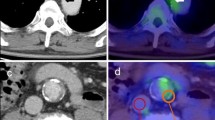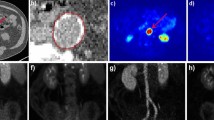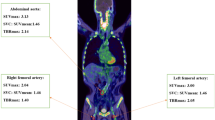Abstract
Objectives
The objective of this study was to evaluate whether baseline 18F-fluorodeoxyglucose (FDG) uptake is associated with carotid plaque progression.
Methods
A total of 156 subjects with carotid plaque were enrolled and underwent carotid magnetic resonance imaging (MRI) (at baseline and the 12-month follow-up) and positron emission tomography-computed tomography (PET-CT) (baseline). Carotid plaque progression was evaluated by two indices (the incidence of plaque progression and percentage of plaque increase) with three-dimensional (3D) imaging, while the 18F-FDG uptake was evaluated by the 18F-FDG uptake levels and 18F-FDG uptake velocity. The association between plaque progression and 18F-FDG uptake was investigated by the trend test and multivariate logistic regression analysis.
Results
Of the 156 subjects, 80 (51.3%) showed carotid plaque progression during the 12-month follow-up. Firstly, no association was found between 18F-FDG uptake levels and plaque progression. Secondly, significant differences in the incidence of plaque progression were observed among the groups with different uptake velocities, showing a significant decreasing trend ranging from high to intermediate to low (p = 0.002, trend test). After adjusting for covariates, an adequate prediction of the 18F-FDG uptake velocity for the incidence of plaque progression was revealed (OR = 0.682, p < 0.05). In addition, no association was found between the 18F-FDG uptake velocity and the percentage of plaque increase in the subjects with plaque progression (p = 0.757, trend test).
Conclusions
Our findings suggest 18F-FDG uptake velocity is independently associated with the incidence of carotid plaque progression. Additionally, the 18F-FDG uptake velocity, as another important parameter of PET-CT, warrants further study in future clinical research.
Key Points
• The18F-FDG uptake levels were not associated with the carotid plaque progression.
• The18F-FDG uptake velocity could predict the incidence of carotid plaque progression.
• The18F-FDG uptake velocity with related factors warrants more attention in future clinical research.






Similar content being viewed by others
Abbreviations
- FDG:
-
Fluorodeoxyglucose
- ICC:
-
Intragroup correlation coefficient
- MRI:
-
Magnetic resonance imaging
- MRS:
-
Magnetic resonance spectroscopy
- PET-CT:
-
Positron emission tomography-computed tomography
- ROC:
-
Receiver operating curve
- SUV:
-
Maximum standard uptake value
- TBR:
-
Target-to-background ratio
- VIF:
-
Variance inflation factor
References
Meschia JF, Bushnell C, Boden-Albala B et al (2014) Guidelines for the primary prevention of stroke: a statement for healthcare professionals from the American Heart Association/American Stroke Association. Stroke 45:3754–3832
Huet P, Burg S, Le Guludec D, Hyafil F, Buvat I (2015) Variability and uncertainty of 18F-FDG PET imaging protocols for assessing inflammation in atherosclerosis: suggestions for improvement. J Nucl Med 56:552–559
Dweck MR, Aikawa E, Newby DE et al (2016) Noninvasive molecular imaging of disease activity in atherosclerosis. Circ Res 119:330–340
van der Valk FM, Kroon J, Potters WV et al (2014) In vivo imaging of enhanced leukocyte accumulation in atherosclerotic lesions in humans. J Am Coll Cardiol 64:1019–1029
Hyafil F, Schindler A, Sepp D et al (2016) High-risk plaque features can be detected in non-stenotic carotid plaques of patients with ischaemic stroke classified as cryptogenic using combined (18)F-FDG PET/MR imaging. Eur J Nucl Med Mol Imaging 43:270–279
Rudd JH, Narula J, Strauss HW et al (2010) Imaging atherosclerotic plaque inflammation by fluorodeoxyglucose with positron emission tomography: ready for prime time? J Am Coll Cardiol 55:2527–2535
Hammad B, Evans NR, Rudd JHF, Tawakol A (2017) Molecular imaging of atherosclerosis with integrated PET imaging. J Nucl Cardiol 24:938–943
Sun J, Zhao XQ, Balu N et al (2017) Carotid plaque lipid content and fibrous Cap status predict systemic CV outcomes: the MRI substudy in AIM-HIGH. JACC Cardiovasc Imaging 10:241–249
McNally JS, McLaughlin MS, Hinckley PJ et al (2015) Intraluminal thrombus, intraplaque hemorrhage, plaque thickness, and current smoking optimally predict carotid stroke. Stroke 46:84–90
Joseph P, Ishai A, Mani V et al (2017) Short-term changes in arterial inflammation predict long-term changes in atherosclerosis progression. Eur J Nucl Med Mol Imaging 44:141–150
Xu D, Hippe DS, Underhill HR et al (2014) Prediction of high-risk plaque development and plaque progression with the carotid atherosclerosis score. JACC Cardiovasc Imaging 7:366–373
Mehta NN, Torigian DA, Gelfand JM, Saboury B, Alavi A (2012) Quantification of atherosclerotic plaque activity and vascular inflammation using [18-F] fluorodeoxyglucose positron emission tomography/computed tomography (FDG-PET/CT). J Vis Exp. https://doi.org/10.3791/3777:e3777
Harris RS, Venegas JG, Wongviriyawong C et al (2011) 18F-FDG uptake rate is a biomarker of eosinophilic inflammation and airway response in asthma. J Nucl Med 52:1713–1720
Bosmans B, Famaey N, Verhoelst E, Bosmans J, Vander Sloten J (2016) A validated methodology for patient specific computational modeling of self-expandable transcatheter aortic valve implantation. J Biomech 49:2824–2830
Gold MEL, Norell MA, Budassi M, Vaska P, Schulz D (2018) Rapid (18)F-FDG uptake in brain of awake, behaving rat and anesthetized chicken has implications for behavioral PET studies in species with high metabolisms. Front Behav Neurosci 12:115
Tarkin JM, Dweck MR, Evans NR et al (2016) Imaging atherosclerosis. Circ Res 118:750–769
Zhang R, Zhou Y, Liu C et al (2017) Overestimation of susceptibility vessel sign: a predictive marker of stroke cause. Stroke 48:1993–1996
Duivenvoorden R, van Wijk D, Klimas M, Kastelein JJ, Stroes ES, Nederveen AJ (2013) Detection of liquid phase cholesteryl ester in carotid atherosclerosis by 1H-MR spectroscopy in humans. JACC Cardiovasc Imaging 6:1277–1284
Steinl DC, Kaufmann BA (2015) Ultrasound imaging for risk assessment in atherosclerosis. Int J Mol Sci 16:9749–9769
Wilson SR, Lin FY, Min JK (2011) Role of coronary artery calcium score and coronary CT angiography in the diagnosis and risk stratification of individuals with suspected coronary artery disease. Curr Cardiol Rep 13:271–279
Bouma BE, Villiger M, Otsuka K, Oh WY (2017) Intravascular optical coherence tomography [Invited]. Biomed Opt Express 8:2660–2686
Ammirati E, Moroni F, Pedrotti P et al (2014) Non-invasive imaging of vascular inflammation. Front Immunol 5:399
Luijendijk P, Lu H, Heynneman FB et al (2014) Increased carotid intima-media thickness predicts cardiovascular events in aortic coarctation. Int J Cardiol 176:776–781
Zavodni AE, Wasserman BA, McClelland RL et al (2014) Carotid artery plaque morphology and composition in relation to incident cardiovascular events: the Multi-Ethnic Study of Atherosclerosis (MESA). Radiology 271:381–389
Derlin T, Richter U, Bannas P et al (2010) Feasibility of 18F-sodium fluoride PET/CT for imaging of atherosclerotic plaque. J Nucl Med 51:862–865
Funding
This work was supported by National Natural Science Foundation of China (81871343, 81525014), Jiangsu Provincial Key Research and Development Plan (BE2017699, BE2017698, BE2018693), and Natural Science Foundation of Jiangsu Province (BK20181226, BK20171311).
Author information
Authors and Affiliations
Corresponding authors
Ethics declarations
Guarantor
The scientific guarantor of this publication is Jinchuan Yan.
Conflict of interest
The authors have no potential conflicts of interest relevant to this article.
Statistics and biometry
No complex statistical methods were necessary for this paper.
Informed consent
Written informed consent was waived by the institutional review board.
Ethical approval
Institutional review board approval was obtained.
Methodology
• retrospective
• observational
• performed at one institution
Additional information
Publisher’s note
Springer Nature remains neutral with regard to jurisdictional claims in published maps and institutional affiliations.
Electronic supplementary material
ESM 1
(DOCX 726 kb)
Rights and permissions
About this article
Cite this article
Li, Y., Liang, Y., Yang, P. et al. 18F-FDG uptake velocity but not uptake level is associated with progression of carotid plaque. Eur Radiol 30, 2403–2411 (2020). https://doi.org/10.1007/s00330-019-06535-8
Received:
Revised:
Accepted:
Published:
Issue Date:
DOI: https://doi.org/10.1007/s00330-019-06535-8




